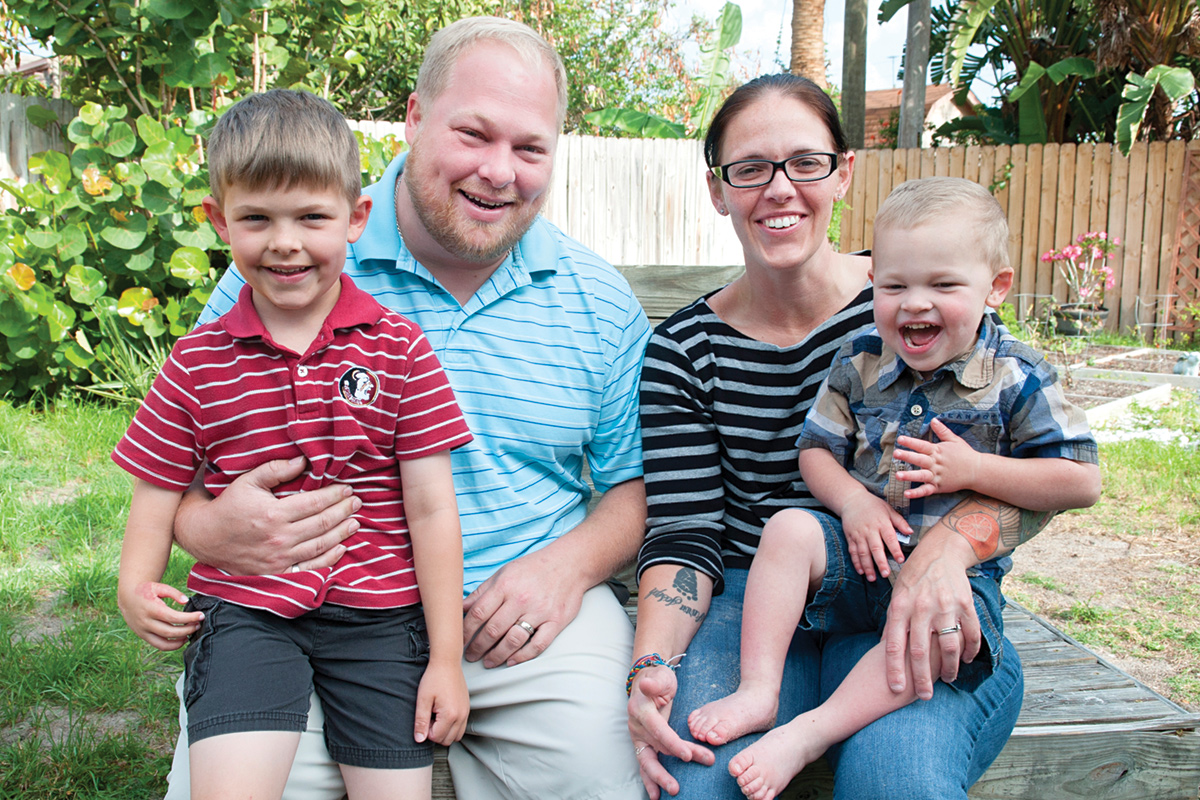Missing: Gene 3q29
Leading research explores a genetic link to increased risk for schizophrenia

Annemarie Poyo Furlong
It’s difficult to imagine anything more worrisome than a pediatrician saying, “Test results show a problem with your child’s DNA, but it’s something I’ve never seen before, and I don’t know what it means.”
That was the unexpected news Aaron and Jenna Gallagher of Palm Bay, Florida, received about their younger son Luke shortly after he was born in August 2014.
Luke Gallagher is afflicted with a rare genetic mutation called 3q29 deletion syndrome, according to Jennifer Mulle, assistant professor of human genetics at Emory. Thanks to a $3.1 million grant from the National Institutes of Health (NIH), she is coprincipal investigator of a multidisciplinary Emory team performing first-of-its-kind research on the syndrome.
“Normally, each parent contributes a complete copy of their DNA to their unborn child,” Mulle explains. In about one in thirty thousand births, a specific segment of twenty-two genes from the end of one or the other parent’s No. 3 chromosome is deleted by unknown means and fails to occur in the child’s DNA.
This 3q29 deletion syndrome has been associated with feeding disorders, behavioral problems, failure to meet certain developmental benchmarks, and a range of neuropsychiatric conditions—including mild-to-moderate intellectual disability, anxiety, autism, and a forty-fold increased risk for schizophrenia.
That’s quite a range of potential health issues, which is why it’s important to understand the function of the deleted gene segment, says Mulle.
“Even with intellectual disability, we see kids who are in normal classes and do fine, and then we have kids at the other end who are nonverbal, need special education, and may never live independently,” she says. “Just because your child has 3q29 deletion syndrome does not mean they’re automatically going to have autism, schizophrenia, anxiety disorder, or any other related issues, but the risk is increased.”
In the NIH research project, the team led by Mulle and Gary Bassell, professor and chair of the Department of Cell Biology, will engineer pairs of cell lines with and without the 3q29 deletion for study—a so-called “disease in a dish.” This is accomplished by taking blood cells from healthy individuals and, using induced pluripotent stem cell technology, turning them back into stem cells, then reprogramming them to redevelop into neurons.
Next, researchers will use a gene-manipulation tool to remove the twenty-two genes in the 3q29 region from some cell lines, leaving others intact and normal.
“Then we can compare how neurons would behave in a person without the syndrome versus neurons in a person with the syndrome,” Mulle says. Researchers hope to acquire a better understanding of the molecular-cellular mechanism behind schizophrenia—the “great white whale” of genetics.
Another project goal, in collaboration with the Marcus Autism Center and Emory’s Departments of Psychology and Psychiatry, is to collect and disseminate detailed information about 3q29 deletion syndrome to parents and medical professionals.
During Luke’s first months, a lack of basic information left the Gallaghers to fend for themselves. The baby struggled with severe eczema and frequent, violent vomiting— a parent’s nightmare. Switching formulas didn’t help, and allergy tests revealed nothing.
His medical situation was complicated by a congenital heart defect. At birth, the left side of his heart was only half normal size, and a series of risky operations was scheduled. Miraculously, the heart began to grow, and within eleven days had achieved 98 percent of its proper size, rendering surgery unnecessary. It was his heart condition that prompted a DNA test and led to the 3q29 deletion syndrome diagnosis.
A few months later, the Gallaghers could finally focus their attention on learning more about the mysterious 3q29 deletion syndrome. They spent a lot of time searching and eventually found a Facebook community of parents whose kids have 3q29 deletion syndrome.
“It was a blessing for us to be able to talk to other parents and see that our son has some of the same issues that they’re dealing with,” Aaron Gallagher recalls.
They also began communicating with Mulle through the group, and joined more than one hundred syndrome carriers in the Emory research team’s international 3q29 deletion registry.
Approaching his third birthday, Luke loves Thomas the Tank Engine and Paw Patrol.
“He gets excited about all the things that little kids get excited about,” his father says. “It’s wonderful seeing him grow up.”
But there are other times when he’s seemingly unable to control himself and can become physically violent. And although he tries hard, Luke manages a vocabulary of only about twenty words, so verbal communication is a concern. His future independence is uncertain.
Ultimately, Mulle and her research team hope to help kids like Luke by discovering new treatments to mitigate the effects of 3q29 deletion syndrome. A future direction for their work would be to assay dozens of the “disease in a dish” specimens to screen hundreds of chemical compounds, “to see if there’s an agent that can fix any deficits we find,” she says. “The answer is right there. We just have to get to it.”


